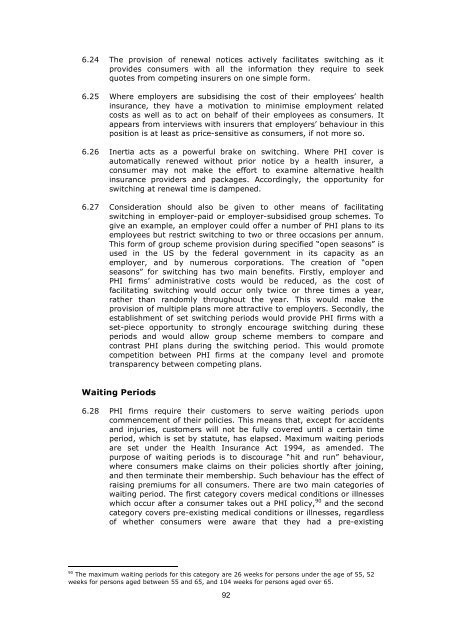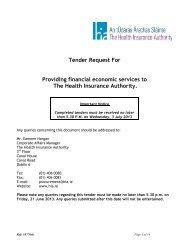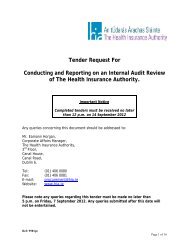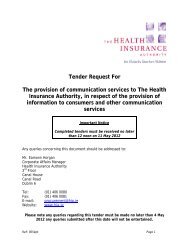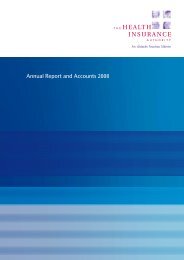Competition in the Irish Private Health Insurance Market
Competition in the Irish Private Health Insurance Market
Competition in the Irish Private Health Insurance Market
You also want an ePaper? Increase the reach of your titles
YUMPU automatically turns print PDFs into web optimized ePapers that Google loves.
6.24 The provision of renewal notices actively facilitates switch<strong>in</strong>g as it<br />
provides consumers with all <strong>the</strong> <strong>in</strong>formation <strong>the</strong>y require to seek<br />
quotes from compet<strong>in</strong>g <strong>in</strong>surers on one simple form.<br />
6.25 Where employers are subsidis<strong>in</strong>g <strong>the</strong> cost of <strong>the</strong>ir employees’ health<br />
<strong>in</strong>surance, <strong>the</strong>y have a motivation to m<strong>in</strong>imise employment related<br />
costs as well as to act on behalf of <strong>the</strong>ir employees as consumers. It<br />
appears from <strong>in</strong>terviews with <strong>in</strong>surers that employers’ behaviour <strong>in</strong> this<br />
position is at least as price-sensitive as consumers, if not more so.<br />
6.26 Inertia acts as a powerful brake on switch<strong>in</strong>g. Where PHI cover is<br />
automatically renewed without prior notice by a health <strong>in</strong>surer, a<br />
consumer may not make <strong>the</strong> effort to exam<strong>in</strong>e alternative health<br />
<strong>in</strong>surance providers and packages. Accord<strong>in</strong>gly, <strong>the</strong> opportunity for<br />
switch<strong>in</strong>g at renewal time is dampened.<br />
6.27 Consideration should also be given to o<strong>the</strong>r means of facilitat<strong>in</strong>g<br />
switch<strong>in</strong>g <strong>in</strong> employer-paid or employer-subsidised group schemes. To<br />
give an example, an employer could offer a number of PHI plans to its<br />
employees but restrict switch<strong>in</strong>g to two or three occasions per annum.<br />
This form of group scheme provision dur<strong>in</strong>g specified “open seasons” is<br />
used <strong>in</strong> <strong>the</strong> US by <strong>the</strong> federal government <strong>in</strong> its capacity as an<br />
employer, and by numerous corporations. The creation of “open<br />
seasons” for switch<strong>in</strong>g has two ma<strong>in</strong> benefits. Firstly, employer and<br />
PHI firms’ adm<strong>in</strong>istrative costs would be reduced, as <strong>the</strong> cost of<br />
facilitat<strong>in</strong>g switch<strong>in</strong>g would occur only twice or three times a year,<br />
ra<strong>the</strong>r than randomly throughout <strong>the</strong> year. This would make <strong>the</strong><br />
provision of multiple plans more attractive to employers. Secondly, <strong>the</strong><br />
establishment of set switch<strong>in</strong>g periods would provide PHI firms with a<br />
set-piece opportunity to strongly encourage switch<strong>in</strong>g dur<strong>in</strong>g <strong>the</strong>se<br />
periods and would allow group scheme members to compare and<br />
contrast PHI plans dur<strong>in</strong>g <strong>the</strong> switch<strong>in</strong>g period. This would promote<br />
competition between PHI firms at <strong>the</strong> company level and promote<br />
transparency between compet<strong>in</strong>g plans.<br />
Wait<strong>in</strong>g Periods<br />
6.28 PHI firms require <strong>the</strong>ir customers to serve wait<strong>in</strong>g periods upon<br />
commencement of <strong>the</strong>ir policies. This means that, except for accidents<br />
and <strong>in</strong>juries, customers will not be fully covered until a certa<strong>in</strong> time<br />
period, which is set by statute, has elapsed. Maximum wait<strong>in</strong>g periods<br />
are set under <strong>the</strong> <strong>Health</strong> <strong>Insurance</strong> Act 1994, as amended. The<br />
purpose of wait<strong>in</strong>g periods is to discourage “hit and run” behaviour,<br />
where consumers make claims on <strong>the</strong>ir policies shortly after jo<strong>in</strong><strong>in</strong>g,<br />
and <strong>the</strong>n term<strong>in</strong>ate <strong>the</strong>ir membership. Such behaviour has <strong>the</strong> effect of<br />
rais<strong>in</strong>g premiums for all consumers. There are two ma<strong>in</strong> categories of<br />
wait<strong>in</strong>g period. The first category covers medical conditions or illnesses<br />
which occur after a consumer takes out a PHI policy, 90 and <strong>the</strong> second<br />
category covers pre-exist<strong>in</strong>g medical conditions or illnesses, regardless<br />
of whe<strong>the</strong>r consumers were aware that <strong>the</strong>y had a pre-exist<strong>in</strong>g<br />
90 The maximum wait<strong>in</strong>g periods for this category are 26 weeks for persons under <strong>the</strong> age of 55, 52<br />
weeks for persons aged between 55 and 65, and 104 weeks for persons aged over 65.<br />
92


